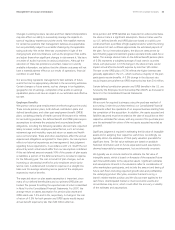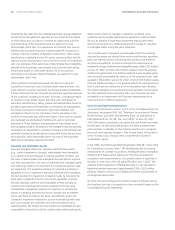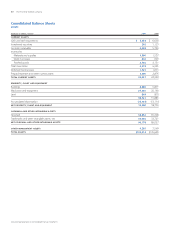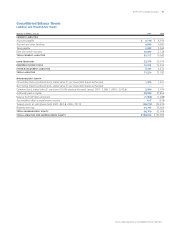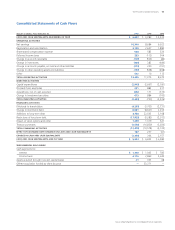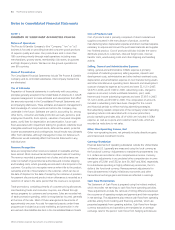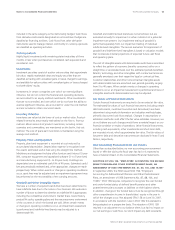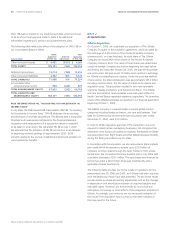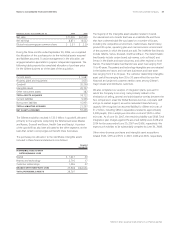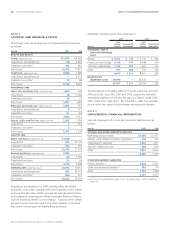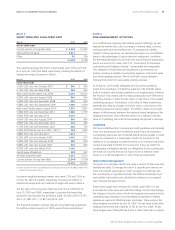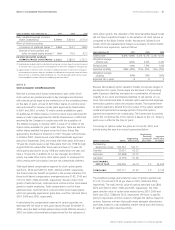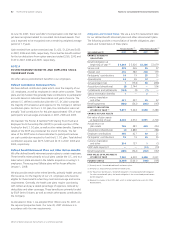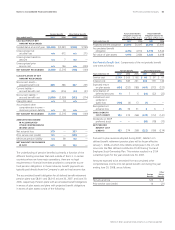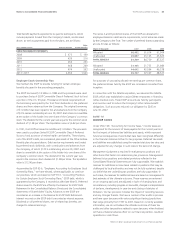Proctor and Gamble 2007 Annual Report Download - page 57
Download and view the complete annual report
Please find page 57 of the 2007 Proctor and Gamble annual report below. You can navigate through the pages in the report by either clicking on the pages listed below, or by using the keyword search tool below to find specific information within the annual report.Millions of dollars except per share amounts or as otherwise specied.
Notes to Consolidated Financial Statements The Procter & Gamble Company 55
included in the same category as the items being hedged. Cash ows
from derivative instruments designated as net investment hedges are
classied as nancing activities. Cash ows from other derivative
instruments used to manage interest, commodity or currency exposures
are classied as operating activities.
Highly liquid investments with remaining stated maturities of three
months or less when purchased are considered cash equivalents and
recorded at cost.
Investment securities consist of auction rate securities that approximate
fair value, readily marketable debt and equity securities that are
classied as trading with unrealized gains or losses charged to earnings,
and available-for-sale securities with unrealized gains or losses charged
to shareholders’ equity.
Investments in certain companies over which we exert signicant
inuence, but do not control the nancial and operating decisions,
are accounted for as equity method investments. Other investments
that are not controlled, and over which we do not have the ability to
exercise signicant inuence, are accounted for under the cost method
and are included in other noncurrent assets.
Inventories are valued at the lower of cost or market value. Product-
related inventories are primarily maintained on the rst-in, rst-out
method. Minor amounts of product inventories, including certain
cosmetics and commodities, are maintained on the last-in, rst-out
method. The cost of spare part inventories is maintained using the
average cost method.
Property, plant and equipment is recorded at cost reduced by
accumulated depreciation. Depreciation expense is recognized over
the assets’ estimated useful lives using the straight-line method.
Machinery and equipment includes ofce furniture and xtures (15-year
life), computer equipment and capitalized software (3- to 5-year lives)
and manufacturing equipment (3- to 20-year lives). Buildings are
depreciated over an estimated useful life of 40 years. Estimated useful
lives are periodically reviewed and, when appropriate, changes are made
prospectively. When certain events or changes in operating conditions
occur, asset lives may be adjusted and an impairment assessment may
be performed on the recoverability of the carrying amounts.
We have a number of acquired brands that have been determined to
have indenite lives due to the nature of our business. We evaluate a
number of factors to determine whether an indenite life is appropriate,
including the competitive environment, market share, brand history,
product life cycles, operating plans and the macroeconomic environment
of the countries in which the brands are sold. When certain events
or changes in operating conditions occur, an impairment assessment
is performed and indenite-lived brands may be adjusted to a
determinable life.
Goodwill and indenite-lived brands are not amortized, but are
evaluated annually for impairment or when indicators of a potential
impairment are present. Our impairment testing of goodwill is
performed separately from our impairment testing of individual
indenite-lived intangibles. The annual evaluation for impairment of
goodwill and indenite-lived intangibles is based on valuation models
that incorporate internal projections of expected future cash ows
and operating plans.
The cost of intangible assets with determinable useful lives is amortized
to reect the pattern of economic benets consumed, either on a
straight-line or accelerated basis over the estimated periods beneted.
Patents, technology and other intangibles with contractual terms are
generally amortized over their respective legal or contractual lives.
Customer relationships and other noncontractual intangible assets
with determinable lives are amortized over periods generally ranging
from 5 to 40 years. When certain events or changes in operating
conditions occur, an impairment assessment is performed and lives of
intangible assets with determinable lives may be adjusted.
Certain nancial instruments are required to be recorded at fair value.
The estimated fair values of such nancial instruments (including certain
debt instruments, investment securities and derivatives) have been
determined using market information and valuation methodologies,
primarily discounted cash ow analysis. Changes in assumptions or
estimation methods could affect the fair value estimates. However, we
do not believe any such changes would have a material impact on our
nancial condition or results of operations. Other nancial instruments,
including cash equivalents, other investments and short-term debt,
are recorded at cost, which approximates fair value. The fair values of
long-term debt and derivative instruments are disclosed in Note 5 and
Note 6, respectively.
Other than as described below, no new accounting pronouncement
issued or effective during the scal year has had or is expected to
have a material impact on the Consolidated Financial Statements.
In September 2006, the FASB issued SFAS 158, “Employers’
Accounting for Dened Benet Pension and Other Postretirement
Plans, an amendment of FASB Statements No. 87, 88, 106, and
132(R).” SFAS 158 requires companies to recognize the over-funded
and under-funded status of dened benet pension and other
postretirement plans as assets or liabilities on their balance sheets.
In addition, changes in the funded status must be recognized through
other comprehensive income in shareholders’ equity in the year in
which the changes occur. We adopted SFAS 158 on June 30, 2007.
In accordance with the transition rules in SFAS 158, this standard is
being adopted on a prospective basis. The adoption of SFAS 158
resulted in an adjustment to our balance sheet, but had no impact on
our net earnings or cash ow, nor did it impact any debt covenants.


